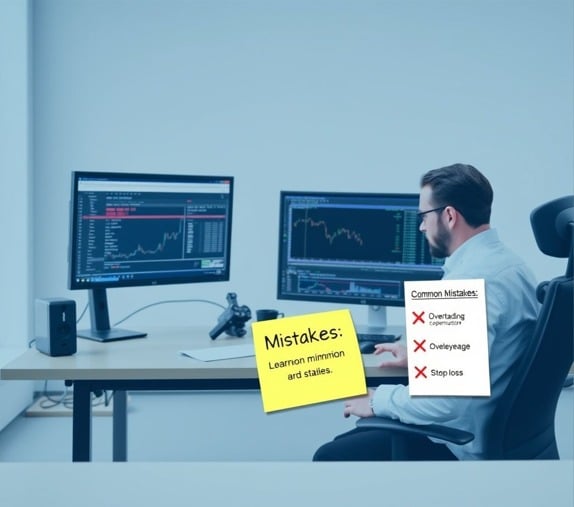Prop Trading Common Mistakes: Top Errors New Traders Must Avoid
Introduction: Understanding Prop Trading Common Mistakes
Entering the world of proprietary trading is an exciting opportunity. However, the path to success is often littered with pitfalls. One of the first things aspiring traders need to understand is the concept of prop trading common mistakes. Identifying and avoiding these early missteps can help build a sustainable and profitable trading career.
At Larsa Capital, many new traders arrive full of potential but fall prey to preventable errors. With the right guidance, discipline, and mindset, most of these mistakes can be corrected or entirely avoided. Let’s dive deep into the most frequent issues and how to prevent them.
Lack of a Structured Trading Plan
Many new traders dive into the markets without a concrete trading plan. This lack of preparation is one of the most dangerous prop trading common mistakes.
Consequences of Trading Without a Plan
- Inconsistent performance
- Emotional decision-making
- Difficulty in measuring and improving results
Creating a trading plan with specific entry, exit, and risk parameters allows traders to stay focused and avoid impulsive behavior.
Ignoring Risk Management Rules
Risk management is often overlooked in the excitement of making fast profits.
How Poor Risk Control Leads to Disaster
- Overleveraging trades
- Exceeding daily loss limits
- Failing to use stop-loss orders
Every professional trader knows that risk control is the cornerstone of long-term survival. A solid risk plan includes position sizing, loss limits, and clear contingency actions.
Overtrading and Revenge Trading
Greed and frustration are powerful drivers. Unfortunately, they often lead new traders into the trap of overtrading or revenge trading.
What Fuels Overtrading?
- Desire to recover losses quickly
- Chasing market action without analysis
- Lack of discipline or boredom
To stay in control, traders must limit daily trade counts and always analyze setups before entering positions.
Misunderstanding the Evaluation Criteria
Many traders don’t fully grasp the rules of their prop trading firm. This often leads to violations and disqualification.
Common Rule-Based Mistakes
- Not tracking daily drawdown limits
- Holding trades over news events
- Trading outside allowed hours or assets
At Larsa Capital, clear guidelines are provided to every trader. Reading and understanding them can prevent unnecessary breaches and losses.
Trading Without Backtesting
One of the most crucial steps in system development is backtesting. Skipping this phase can be costly.
Why Backtesting Matters
- Helps evaluate strategy effectiveness
- Identifies historical win rates and drawdowns
- Builds trader confidence
A well-tested strategy gives a statistical edge and improves consistency over time.
Relying on Signals or Copy Trading
New traders often look for shortcuts and may follow signals or copy trades without understanding them.
Why This Is a Trap
- Lack of strategy ownership
- No learning or skill development
- Blind following leads to poor risk understanding
It’s essential to build your own approach and take responsibility for every trade.
Overconfidence After Winning Streaks
Winning streaks can create a false sense of invincibility. This is one of the sneakier prop trading common mistakes.
Signs of Overconfidence
- Increasing trade size without reason
- Ignoring risk protocols
- Taking random trades
Staying humble and sticking to your plan keeps your trading grounded and consistent.
Underestimating Emotional Discipline
Trading is as much mental as it is technical. Emotional control is what separates successful traders from the rest.
Emotional Triggers to Watch
- Fear after losses
- Greed after wins
- Impatience in sideways markets
Traders should use journaling, regular breaks, and post-trade reviews to manage emotions effectively.
Not Tracking or Reviewing Trades
Without tracking, traders cannot measure or improve.
Benefits of a Trading Journal
- Identifies patterns of success and failure
- Supports emotional regulation
- Creates a feedback loop for growth
Every trader should keep detailed logs of trades and analyze them weekly.
Lack of Adaptability
Markets change, and so should your strategy.
Signs You Need to Adapt
- Strategy suddenly stops working
- Market volatility increases or decreases significantly
- News events start impacting your results more than usual
Being open to learning and adjusting can prevent stagnation and long-term losses.
How Larsa Capital Helps Traders Avoid These Mistakes
Larsa Capital provides educational resources, real-time dashboards, and mentoring to ensure traders avoid these common pitfalls. From structured evaluations to advanced risk tools, the firm is built to support trader success at every stage.
Conclusion: Build the Right Habits Early
Avoiding these prop trading common mistakes isn’t just about saving money. It’s about building the right mindset, routine, and foundation for lasting success. By developing discipline, understanding risk, and constantly reviewing your performance, you’ll be far ahead of most new traders.
With firms like Larsa Capital offering structured paths and real-time support, there’s no better time to step into prop trading—prepared and informed.

